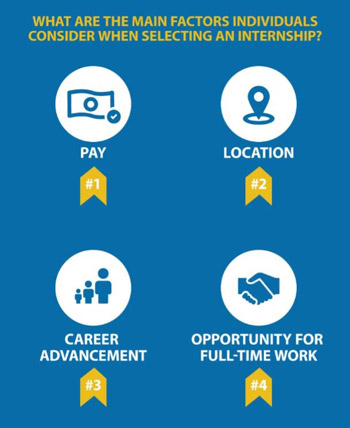
What can you learn from your company’s intern conversion rate?
According to the National Association of Colleges and Employers, intern-to-hire conversion rates slipped nearly 11 points in 2017 to 51.3 percent; down from a thirteen-year high of 61.9 percent 2016. Understanding intern-to-hire conversion, along with what’s influencing early career decision-making, stands to have a major impact on a company’s bottom-line. If organizations aren’t hitting their conversion rate goals—or worse, don’t have intern conversion goals—it may be time to crunch some numbers.
On the surface, conversion rates are just statistics—they only tell part of the story. High internship conversions could signal that employment offers are attractive, or they could reflect a slow, non-competitive market. To understand what your conversion rate really means, you’ll have to dig a little deeper.
Know where you stand.
To calculate your intern conversion rate divide the number of accepted offers by the number of eligible interns, and multiply by 100.
For example: 75 accepted offers ÷ 125 eligible interns = 0.60
0.60 x 100 = 60% conversion rate
Attracting and retaining your top interns means understanding what interns want from their early career work experience. Matching your culture and workplace experience to the young talent that will become your future leaders is vital to attracting and retaining these future rock stars.
Your conversion rate can also help you determine how effective your internship program is as a recruiting tool. According to the NACE, if you are using your internship program as a recruiting tool, your conversion goal should be at least 50 percent of your eligible interns to full-time hires.
Refining your recruiting processes to identify the best candidates for your program will have a direct impact on your intern conversion rate. Which college and university programs yield the top talent for your organization? Which degree programs and candidate demographics produce the highest offer acceptance rates? Leverage technology and advanced internship program management solutions to analyze and profile the interns who thrive in your environment then hone your recruiting efforts to identify the best candidates for your future internship programs.

It’s not you; it’s me.
Most companies offering internship programs intend to fill open full-time positions from this rich pool of known top candidates. The closer the company’s actual hiring rate comes to their target hiring rate, the more early-career positions they fill with known great talent. But what happens when interns decline offers for full-time employment? Conversion stats take a hit—but the larger impact is an organization’s lost opportunity to add talented, and potentially trained, new employees to the company rosters.
Exit interviews and online surveys rarely shed light on the real reasons interns don’t convert to full-time employees. Combatting early attrition (and a failure to convert interns is a form of early attrition), is a growing problem for organizations. Early employee attrition can drastically affect an organization’s bottom line.
Employees want more than a job and benefits. The average voluntary turnover rate in the U.S. is between 15 and 19 percent. The Society for Human Resources Management (SHRM) estimates an average cost to replace an employee is $4,000 – $5,000. Companies with 2,500 employees could spend more than 2 million dollars each year replacing employees. The cost dramatically increases when new employees leave after just one year.
Combatting early attrition starts with identifying and engaging top talent. Hiring the right early career employees—ones who will thrive in your environment, who know what to expect on day 1, and quickly integrate and contribute to your culture, gives organizations a competitive advantage.
Why hire interns?
Market analysis indicates that interns out-perform non-intern candidates on a number of metrics including cultural fit, speed of onboarding and retention. These young super stars hit the ground running, know your culture and stick around longer—addressing early attrition at the core. According to NACE, retention of employees hired from an in-house internship program exceeded retention metrics of interns hired from external programs and non-intern hires at the 1-year and 5-year marks.

It’s time to tune-in to your interns. With vi, unleashing the power of your interns is easier (and faster) than you think.
Stop Losing Great People®
If you’d like more information about what intelligent, tailored internship management and retention solutions can do for you, we’d love to help you. We can walk you through a demo, share customer success stories and case studies, and give you the resources you need to choose the right solution for your organization. We’re ready to help, contact us for more information or connect with us on Twitter and LinkedIn.